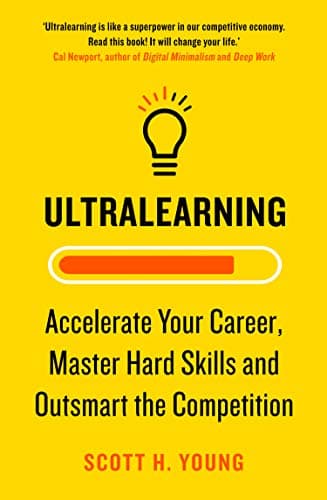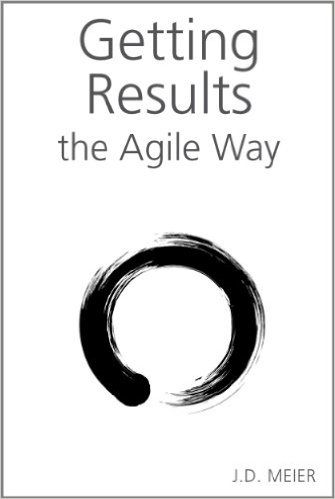
Book Summary: Ultralearning by Scott.H. Young
Ultralearning is a book on how to learn anything that is of interest to you. Often we get stuck with the same 'classroom learning methodology' and don't try anything outside of it. If you are invested in yourself and learning, then I do recommend this book. I am sure you will pick up one or two stra
Table of Contents
Key Thoughts
Ultralearning is a book on how to learn anything that is of interest to you. Often we get stuck with the same 'classroom learning methodology' and don't try anything outside of it. This book introduces different strategies, tips, tricks, and steps to try and test for yourself. If you are invested in yourself and learning, then I do recommend this book. I am sure you will pick up one or two strategies that will help you.
Summary
Ultralearning is a strategy for acquiring skills and knowledge that is self-directed and intense. It puts you in the driver's seat for learning and maximizes effectiveness in learning.
Ultralearning is not easy - It's hard, frustrating, makes you stretch beyond limits - But the accomplishments make it worth the effort!
Rapidly learning new skills can have a significant impact at work. Ultralearning helps you move into the high-skilled category quickly and stay there, with different techniques to learn more things.
Formal education is not always possible and is often costly. Ultralearning is a more accessible and cheaper way to fit learning new things into your schedule.
The core of the Ultralearning strategy is the intensity and willingness to prioritize effectiveness. (Value Up, Over Backlog burndown).
Find time either part-time, during gaps in work or school, or even integrate it into existing learning plans.
Ultralearning is not a cookie-cutter method. Since each person and project is unique, learning methods keep varying. If not it would have been the new way of education.
Ultralearning strategy lays our 9 Principles which can be used as guidelines when starting your next learning project.
1. Metalearning: Learning how to learn
Metalearning is learning about itself and is a higher level of abstraction. Identify the Why, What, and How you are learning something.
Spend around 10% of total learning time in research to clarify the subject you are learning, break it into chunks, find good resources and materials, etc.
Metalearning influences overall strength as a learner and helps find new learning methods, resources, manage time, and motivation. It progressively improves with each project.
Find a sweet spot between insufficient research and analysis paralysis - Research is not an excuse to procrastinate.
2. Focus: Carve out chunks of time
Identify the kind of focus issues that you have.
Are you struggling to Start Focusing (procrastination), sustain focus (getting distracted), or failing to create the right kind of focus?
Acknowledge the real reason is the first step and be conscious about it
3. Directness: Learn by doing
Directness is the idea of learning being tied closely to the context you want to use it in.
Try and create sample projects, or immerse yourself into an environment where you will be forced to learn whatever you are trying to learn.
Learn with an end in mind so that your actions are targeted to the outcome.
4. Drill: Break down small parts and master them and build up
Once you start learning, you will run into challenging topics or concepts. Try and isolate them and focus on improving them in small parts.
Tackle the problems one at a time.
5. Retrieval: Actively recall
After a learning session, try to remember from your memory, rather than going through the book again for revising.
Delay the recall process sufficiently enough to make it more effective.
Using Flash Cards, free recall, asking yourself questions, and self-generated challenges are ways to recall actively.
We avoid testing ourselves since it is uncomfortable and we avoid seeking information about our skill until we think it will be favorable.
6. Feedback: Use it wisely, remove signal from noise
Fear of feedback often feels more uncomfortable than experiencing the feedback itself.
Focus on valuable feedback and not on getting more. Identify the type of feedback you are getting.
- Outcome → Good/Bad, Grades etc.
- Informational → Tell's what's wrong but not what/how to go about fixing it
- Corrective → How you can fix what you are doing wrong? This is the best feedback and usually hard to get
Feedback is useful only if you remember the lessons from it.
7. Retention: Learn to remember things
Memory decays with time, and it is the default behavior.
Space out the learning sessions. It prevents cramming, and favors spaced repetition.
If possible, try and incorporate the skills or learnings into day-to-day life.
8. Intuition: Understand how things work
When you learn something, try and understand it well to explain it to someone new to the topic. Sharing your learning in other forms like blogs, articles, videos, etc., also makes you understand it well enough.
9. Experimentation: Explore possibilities
Experiment with new learning resources, techniques, and style. Stick with things that you choose long enough before you switch over to something else.
Evaluate and record your experimentation outcomes for future projects. Try and explore different areas and see if you can combine unrelated skills.
Once past the initial learning barrier, getting better or mastering something requires more effort and experimentation.
Ultralearning is not a silver bullet. Pick and choose the strategy that best applies to whatever you are learning.
Take responsibility for your learning - decide what, how, and when to learn!
Rahul Nath Newsletter
Join the newsletter to receive the latest updates in your inbox.

